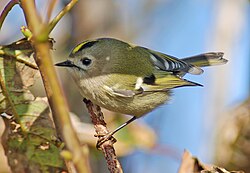Taxonomy
The name of the genus is derived from the Latin regulus, a diminutive of rex, "a king", [2] and refers to the characteristic orange or yellow crests of adult kinglets.
Several forms have only recently had their status clarified. The Madeira firecrest was formerly considered to be a subspecies, R. i. madeirensis, of the common firecrest R. ignicapillus. A phylogenetic analysis based on the cytochrome b gene showed that the Madeiran form is distinct at the species level from the firecrest nominate subspecies R. i. ignicapillus. Cytochrome b gene divergence between the Madeira firecrest and the European bird is 8.5%, comparable with the divergence level between other recognised Regulus species, such as the 9% between the goldcrest and the golden-crowned kinglet. [3] The split was accepted by the Association of European Rarities Committees (AERC) in 2003. [4] The golden-crowned kinglet is similar in appearance to the common firecrest and has been considered to be its New World equivalent, but it is actually closer to the goldcrest. [3]
Goldcrests from the Canary Islands are particularly distinctive having a black forehead, pink-buff underparts and a darker closed wing, [5] and have been sometimes treated either as a subspecies of the common firecrest or as a different Regulus species altogether. [6] They were sometimes called the Tenerife goldcrest, no matter which of the islands they lived on; however, a 2006 study of the vocalisations of these birds indicate that they actually comprise two subspecies of the Goldcrest that are separable on voice; R. r. teneriffae occurring on Tenerife and the newly described subspecies, R. r. ellenthalerae, occurring on the smaller islands of La Palma and El Hierro. [7] The three goldcrest taxa on the Azores, Santa Maria goldcrest, Sao Miguel goldcrest and Western Azores goldcrest, represent recent colonisations from Europe, and are best treated as subspecies. [8]
The relationships of the flamecrest or Taiwan firecrest (Regulus goodfellowi) of Taiwan have also been a source of much debate. It is sometimes viewed as a race of firecrest, but its territorial song resembles those of the Himalayan races of goldcrest, and genetic data show that it is the closest relative of that species, and, despite its alternative name, only distantly related to the firecrest. [9] The flamecrest diverged from the Goldcrest 3.0–3.1 mya (million years ago). [10]
This page is based on this
Wikipedia article Text is available under the
CC BY-SA 4.0 license; additional terms may apply.
Images, videos and audio are available under their respective licenses.





